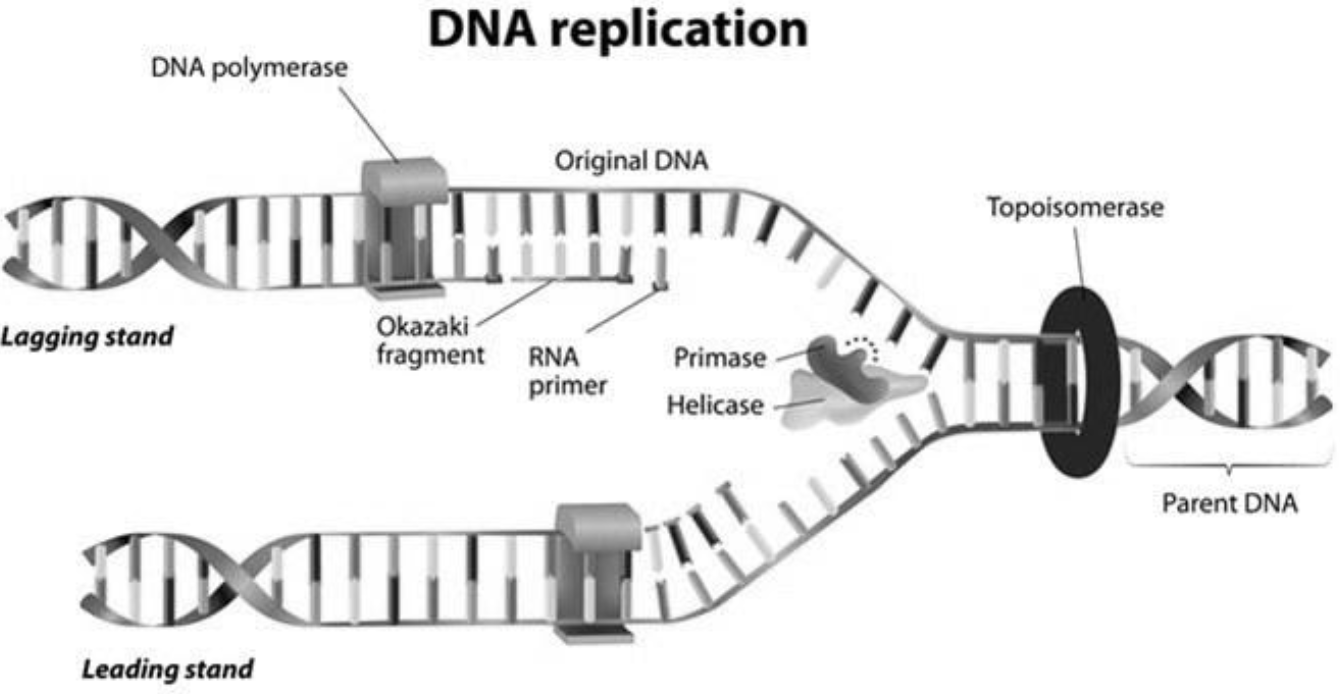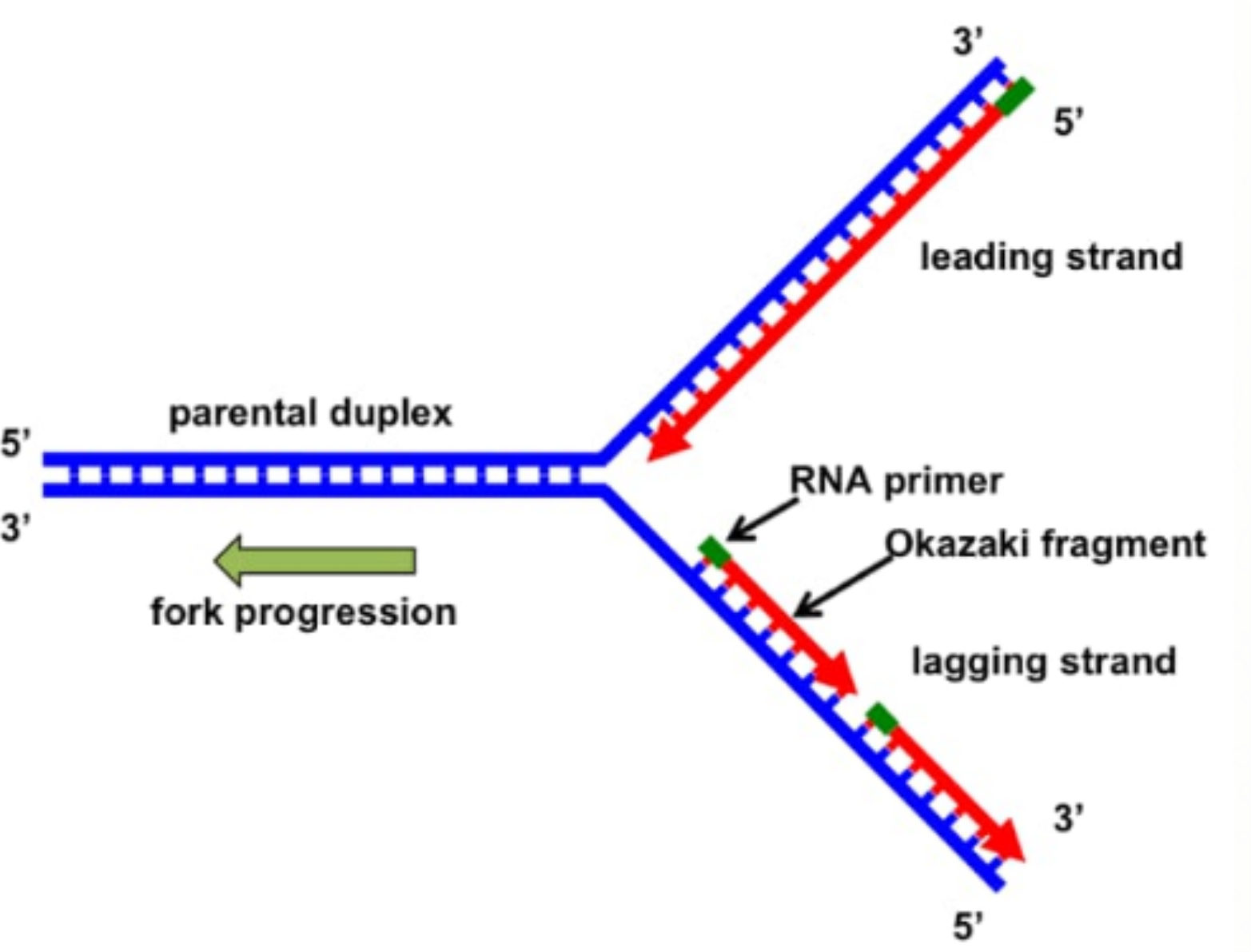Common Errors in DNA Replication and Their Correction Explained
DNA replication is a fundamental biological process where a cell creates an identical copy of its DNA before cell division. This process is essential for growth, repair, and inheritance. Understanding DNA replication helps explain genetic stability, mutations, and diseases. This page explores the definition, steps, errors, and real-life significance of DNA replication in a student-friendly way.
What is DNA Replication? (Definition & Significance)
DNA replication is the process by which a cell duplicates its DNA, ensuring each new cell gets an exact set of genetic instructions. This process preserves genetic information from one cell generation to the next. In our bodies, DNA replication occurs before cell division, supporting growth, tissue repair, and reproduction. Accurate replication is crucial to avoid genetic disorders and maintain health.
DNA Replication Diagram

Steps of DNA Replication (Process Explained)
DNA replication involves a precise sequence of steps, using specific enzymes to copy genetic information accurately. Here is a simple breakdown of the process:
- Initiation: The double helix unwinds at origins of replication, creating a "replication fork."
- Unzipping: Helicase enzyme breaks hydrogen bonds between base pairs, separating DNA strands.
- Primer Binding: Primase enzyme attaches short RNA primers to mark the starting points.
- Elongation: DNA polymerase adds complementary nucleotides (A-T, C-G) to each original strand.
- Leading and Lagging Strands: One strand is synthesized continuously (leading), the other in fragments (lagging/Okazaki fragments).
- Primer Removal and Ligation: RNA primers are replaced by DNA, and ligase joins fragments.
- Termination: The process continues until the entire DNA molecule is copied.
These steps ensure every new cell receives an exact copy of genetic material, as seen in cell division processes like mitosis and meiosis.
Semi-Conservative Nature of DNA Replication
DNA replication is called semi-conservative because each new DNA molecule contains one old (parental) and one newly synthesized strand. This method, proved by the Meselson-Stahl experiment, keeps genetic information stable. It allows mutations to be detected and corrected by repair systems. Understanding this helps explain genetic inheritance and diversity.
Enzymes and Components Involved in DNA Replication
Several enzymes and proteins ensure the speed and accuracy of DNA replication:
- Helicase – Unwinds the DNA double helix.
- Primase – Lays down RNA primers for DNA polymerase to start synthesis.
- DNA Polymerase – Extends the new DNA strand by adding nucleotides.
- Ligase – Seals nicks and joins Okazaki fragments on the lagging strand.
- Single-Strand Binding Proteins – Stabilize separated strands and prevent them from rejoining.
Each enzyme plays a specific role, enabling efficient and controlled replication, vital for normal cell function and organism survival.
DNA Replication Fork

The replication fork is a Y-shaped structure where the DNA splits into two single strands, each acting as a template. The leading strand forms continuously, while the lagging strand forms in short fragments. This structure is essential for understanding the direction and efficiency of DNA polymerase enzymes during replication.
Errors in DNA Replication and Their Correction
While DNA replication is highly accurate, mistakes do occasionally occur. Errors can be:
- Base mismatches: When an incorrect nucleotide is inserted.
- Insertions/Deletions: Extra or missing nucleotides during replication.
- Strand Slippage: Especially in repetitive DNA regions, leading to insertions or deletions.
Proofreading by DNA polymerase corrects most base mismatches right away. Any errors that slip past are often repaired by mismatch repair enzymes. If errors remain, they may cause permanent mutations, leading to genetic diseases or cancers.
For related reading, explore genetic mutations and their consequences.
Real-World Examples and Applications of DNA Replication
The importance of DNA replication goes beyond biology textbooks:
- Medicine: Faulty replication can cause cancer or inherited diseases.
- Agriculture: Improving crop varieties through genetic engineering relies on understanding DNA replication and repair.
- Forensics: DNA fingerprinting and criminal investigations depend on copying and comparing DNA sequences.
- Biotechnology: Techniques like Polymerase Chain Reaction (PCR) amplify DNA for research, diagnosis, or treatment.
Errors or variations in replication can drive evolution but also pose health risks. To know more about acquired and inherited traits, visit this resource on traits.
Quick DNA Replication Notes and Key Points
- Definition: DNA replication is the process of making an exact copy of a DNA molecule.
- Steps: Initiation, unzipping, primer binding, elongation, leading/lagging synthesis, ligation, termination.
- Enzymes Involved: Helicase, DNA polymerase, primase, ligase, and stabilizing proteins.
- Error Correction: Proofreading by polymerases and mismatch repair enzymes.
- Result: Two identical DNA molecules, each with one parent and one new strand (semi-conservative).
Common DNA Replication Questions
- What is the main goal of DNA replication?
- Which enzymes start and finish replication?
- How is DNA replication different in prokaryotes and eukaryotes?
- How do errors affect organisms?
Vedantu provides reliable explanations and notes for quick understanding. Practice DNA replication MCQs and short notes to strengthen your grasp of this crucial process.
Page Summary
DNA replication ensures that genetic information is passed accurately during cell division. This semi-conservative process uses specialized enzymes to build identical DNA strands and maintain genetic stability. Real-life implications include health, agriculture, and forensic applications. Accurate understanding of DNA replication helps explain hereditary patterns, mutations, and the evolution of life. Vedantu supports your learning journey in these fascinating topics.


FAQs on What is DNA Replication and How Does It Work?
1. What is DNA replication?
DNA replication is the biological process by which a cell copies its DNA, ensuring genetic information is passed to daughter cells during cell division.
- Occurs during the S phase of the cell cycle
- Ensures genetic continuity across generations
- Involves enzymes like DNA polymerase, helicase, and ligase
2. What are the steps involved in DNA replication?
The process of DNA replication comprises several key steps to ensure accurate copying of genetic material:
- Initiation: The double helix unwinds at specific origins.
- Unzipping: Helicase enzyme separates the two strands.
- Primer binding: Short RNA primers are attached by primase.
- Elongation: DNA polymerase adds new nucleotides to build complementary strands.
- Termination: The new DNA molecules are re-coiled and detached.
3. Why is DNA replication called semiconservative?
DNA replication is described as semiconservative because each new DNA molecule contains one old (parental) strand and one new (daughter) strand.
- This mechanism was confirmed by the Meselson and Stahl experiment.
- It preserves genetic information while allowing for accurate copying.
4. Which enzymes are involved in DNA replication?
Several enzymes coordinate to efficiently and accurately replicate DNA:
- Helicase – Unwinds the DNA double helix
- DNA polymerase – Adds nucleotides to form the new DNA strand
- Primase – Synthesizes RNA primers
- Ligase – Seals gaps between Okazaki fragments
5. What is the role of DNA polymerase in replication?
DNA polymerase is the main enzyme responsible for synthesizing new DNA strands by adding nucleotides to the growing chain.
- Ensures high-fidelity base pairing
- Works only in the 5’ to 3’ direction
- Has proofreading abilities to correct mistakes
6. What are Okazaki fragments?
Okazaki fragments are short DNA segments synthesized on the lagging strand during DNA replication.
- Formed because DNA polymerase works only in the 5’ to 3’ direction
- Connected by the enzyme DNA ligase
- Ensure that both strands are replicated simultaneously
7. How does DNA replication differ between prokaryotes and eukaryotes?
DNA replication in prokaryotes and eukaryotes shares the basic mechanism but varies in complexity and structure.
- Prokaryotes: Single origin of replication, circular DNA
- Eukaryotes: Multiple origins of replication, linear DNA with histone proteins
- Replication in eukaryotes is slower and more regulated
8. What is the importance of DNA replication?
DNA replication is essential for growth, repair, and reproduction of cells.
- Ensures each new cell receives an exact copy of genetic material
- Maintains genetic stability across generations
- Prevents genetic disorders caused by errors during replication
9. What happens if there are errors during DNA replication?
Errors during DNA replication can lead to mutations, potentially causing diseases or disorders.
- Proofreading by DNA polymerase reduces the error rate
- Some mutations may be harmless, while others can lead to genetic diseases or cancer
- Cells have repair mechanisms to correct most mistakes
10. Explain the Meselson and Stahl experiment and its significance.
The Meselson and Stahl experiment provided proof that DNA replication is semiconservative.
- Used isotope labeling of nitrogen in DNA
- Demonstrated that each new DNA molecule contains one old and one newly synthesized strand
- Significant for understanding the mechanism of genetic inheritance
11. What is the direction of DNA synthesis during replication?
DNA synthesis during replication always occurs in the 5’ to 3’ direction.
- This is due to the structure of DNA polymerase
- Leading strand is synthesized continuously; lagging strand is made in fragments
12. What is a replication fork?
A replication fork is the Y-shaped region formed during DNA replication where the double helix is separated, and new strands are synthesized.
- Serves as the active site for helicase, primase, and DNA polymerase
- Found at multiple locations along the DNA










